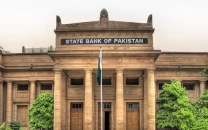Fallout expected: Reckless govt borrowing may cause crisis of confidence
Share of short-term debt with a maturity period of less than a year has increased to 54.2% of total domestic debt.

As of June last year, in terms of GDP, the debt amounted to 61.3% of the worth of all goods and services produced by the country. DESIGN: MUHAMMAD SUHAIB
The government’s failure to introduce reforms has halted the inflow of cheap foreign loans, due to which reliance on short-term debt has increased alarmingly.
According to the Debt Policy Statement 2012-13, submitted to parliament by the Ministry of Finance, the share of short-term debt with a maturity period of less than a year has increased to 54.2% of total domestic debt.
‘Maturity’ refers to the final date on which a loan becomes payable in entirety (the principal amount and interest payments).
The situation may generate a ‘confidence crisis’ in the near term because of investor fears that the government may not be able to meet its obligations due to the insufficient funds at its disposal.
The report highlights that the average maturity of domestic debt has come down to only 1.6 years – with Rs2.5 trillion of debt reaching maturity in less than a year – raising rollover and refinancing risks. Adding Rs1.7 trillion that the government owes to the central bank, 55.3% of the entire domestic debt stock will mature in less than a year.

Following the premature termination of a $11.3 billion bailout programme by the International Monetary Fund, the World Bank and the Asian Development Bank have also suspended annual lending programmes. These multilateral lending institutions are looking for a comprehensive reforms agenda before they restore $3-4 billion in annual funding.
Meanwhile, the government has had to shift almost the entire burden of budget financing to domestic sources.
“Owing to non-availability of sufficient external inflows, the financing focus shifted towards domestic sources, which led to shortening of [the] maturity profile of the public debt,” states the document.
“This avenue is costly. Debt structures that rely heavily on short-term instruments are sources of vulnerability and can potentially generate confidence crisis, fuelled by investor concerns that the government will not have sufficient funds to repay its obligations when they fall due,” the report adds.
During the last fiscal year, out of the Rs821 billion spent on domestic debt servicing, around Rs379.5 billion alone was spent on retiring short-term debts – over 46% of the total spending on domestic debt servicing.
Of that amount, Rs214.5 billion was paid to commercial banks in interest charges, while Rs165 billion was paid to the central bank. However, the interest paid to the central bank returns to the federal government as profits from the State Bank of Pakistan, according to former finance minister Dr Hafeez Pasha.
The paper states that due to the government’s increasing reliance on domestic borrowings, “an increase in interest rates has [had] an adverse fiscal impact” on the economy.
As the central bank is implementing a monetary easing policy, despite the government’s expansionary fiscal policy, the federal government has saved roughly Rs70 billion due to a reduction in interest rates.
Analysts warn of the implications of the expansionary fiscal policy and reckless borrowing from commercial banks at this critical juncture. They say that money borrowed to finance expenditures of a purely political nature will have severe implications for the economy, with signs appearing with a six-month lag in the shape of increased inflationary pressure.
The report underscores another important issue. It proposes that the debt piles be considered in terms of revenues and export earnings, as comparisons with the total size of the economy could be deceptive since many sectors like agriculture are exempt from taxation.
Going with that proposal, Pakistan’s public debt as a percentage of its revenues grew by 493.6% in the period reviewed, while the country consumed roughly 40% of its revenues for servicing such debts, according to the report.
An amount of Rs1.1 trillion was consumed on public debt servicing in the previous fiscal year. As of June last year, in terms of GDP, the debt amounted to 61.3% of the worth of all goods and services produced by the country.
The report seeks comprehensive debt management aimed at keeping the current levels of debt under control and fulfilling future payment obligations.
Published in The Express Tribune, February 6th, 2013.
Like Business on Facebook to stay informed and join in the conversation.



















COMMENTS
Comments are moderated and generally will be posted if they are on-topic and not abusive.
For more information, please see our Comments FAQ